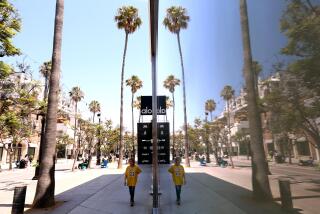Businesses Press for City to Ease Sign Restrictions
THOUSAND OAKS — The Mayor’s Business Roundtable will ask the City Council on Tuesday to discuss relaxing its sign ordinances, a thorny issue that never fails to raise hackles in this appearance-conscious city.
For years, dozens of small business owners and strip mall landlords along Thousand Oaks Boulevard have complained that excessive sign restrictions have hurt their ability to make their presence known.
Some residents and slow-growth advocates, in turn, have long argued that Thousand Oaks’ regulations are necessary to prevent the kind of visual pollution that turned much of the San Fernando Valley into a miniature Glitter Gulch.
Although numerous city-organized committees have discussed the volatile topic, and council members have made some concessions in recent years, many business owners still feel more changes are needed.
The Mayor’s Business Roundtable, which meets regularly to discuss the needs of Thousand Oaks entrepreneurs, is proposing a series of amendments to the city’s sign ordinance--most notably to allow 12-foot monument signs, more colorful strip mall directories and doubling the maximum size for a monument sign from 48 to 96 square feet.
The City Council on Tuesday will consider forming a committee to explore the changes.
“Our main problem is that many businesses don’t have any visibility from the street,” said Houston Lillard, co-owner of the Hampshire Village shopping center along Thousand Oaks Boulevard. “We would like to see the city adopt a more flexible ordinance. It will enhance the boulevard as opposed to creating the messy situation you have in the Valley.”
Mayor Andy Fox, for one, believes the debate over what constitutes a proper sign deserves a fresh look.
“The sign issue never seems to be resolved,” he said. “We need to find a balance. We certainly don’t want to look like the San Fernando Valley, but we also don’t want the current situation, where we basically have people driving around looking for an address.”
Planning Commissioner Marilyn Carpenter, a vocal advocate of low-key signage, disagrees. She believes the topic has been rehashed too many times already and said that if Thousand Oaks wants to avoid turning tacky, it should simply follow the sign guidelines it has already established.
“I thought we had it all resolved,” Carpenter said. “These are all issues that have come up before. Frankly, when you look at the makeup of the Mayor’s Business Roundtable, you can see why they keep coming back.
“I will candidly say that I’m appalled at some of the signs that have been put up as it is,” she added.
The Roundtable believes that the monument signs currently allowed “do not accomplish their aim of adequately identifying business,” according to a report the group submitted to the City Council.
Existing signs are often blocked by parked cars because they are too low to the ground, the report states. Other signs, the report continues, are so restricted in terms of allowable colors and configurations that they cannot even display the complete names and logos of some businesses.
Fox, a big fan of In-N-Out Burger, said he was saddened when the company had to alter the colors of its famous logo to comply with Thousand Oaks’ standards.
“In my view, that’s ridiculous,” Fox said. “That’s carrying things to an extreme. But on the other hand, we don’t want to look like a neon rainbow.
“If you talk to 10 different people about this, you get 10 different opinions.”
Another concern among Thousand Oaks business owners is that the current sign ordinance prevents strip mall owners from featuring the names of some tenants more prominently than others.
Murray Wald, owner of Fran’s Framing at Hampshire Village, said Thousand Oaks has failed for years to listen to complaints from small business owners who are being hurt by the sign ordinance. Because he is located in the rear of the strip mall, he said, he needs a bigger mention in the directory sign to stay in business.
“The City Council has absolutely no understanding of what it takes to run a business,” Wald said. “We’re a big chunk of the tax base in the city, and they need to pay attention to our needs. I think those signs are awfully important. They’re our only hope of staying in business located where we are.”
Councilman Mike Markey said he understands concerns that Thousand Oaks could become littered with ugly monument signs if city leaders are not careful. But he said business owners have raised valid concerns about the restrictions, and Thousand Oaks should be able to meet their needs tastefully.
“When you say ‘monument sign,’ people think of the [Thousand Oaks] Auto Mall,” Markey said, referring to the most disputed sign in the city’s history. “But the fact is, these are not huge signs, and that has to be made clear because this could become very emotional. I don’t see why any homeowners group should be opposed to this.”
More to Read
Sign up for Essential California
The most important California stories and recommendations in your inbox every morning.
You may occasionally receive promotional content from the Los Angeles Times.









